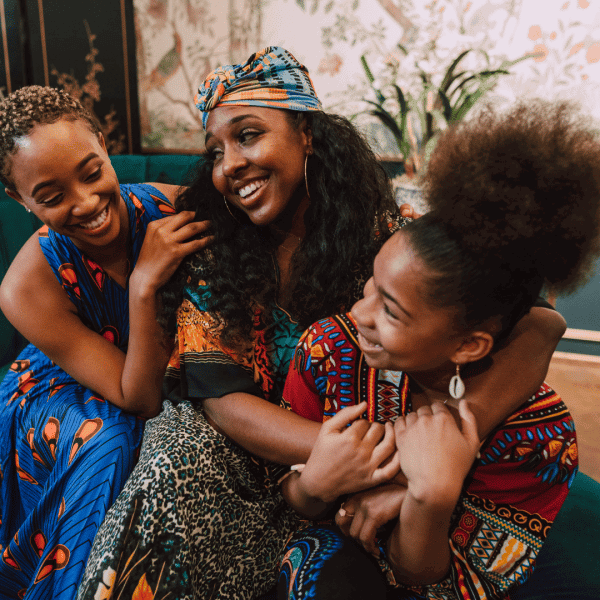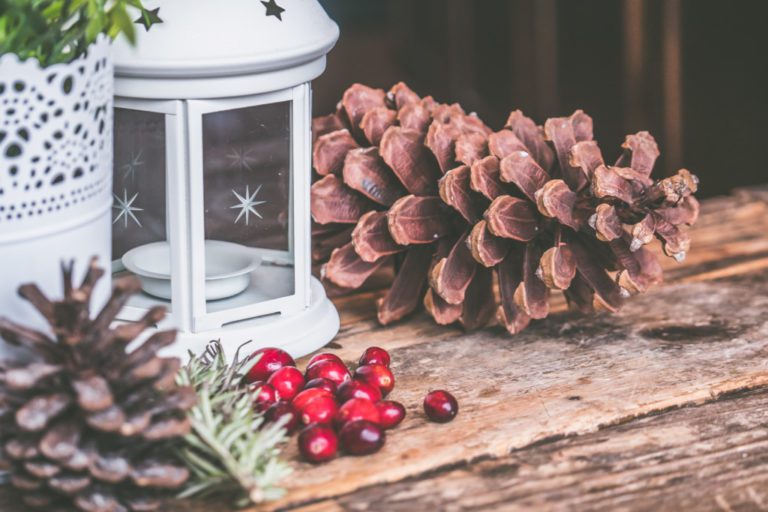Kwanzaa: A Celebration of Culture
Let’s not forget that many holidays are observed and celebrated during the month of December and early January. One of those many holidays happens to be Kwanzaa. A nonreligious and nonpolitical, but cultural holiday that my family began celebrating 5-6 years ago. We began celebrating Kwanzaa as we made a shift from Christmas for religious reasons.
Kwanzaa is a weeklong celebration that was created in 1966 to affirm the cultural significance of community, family, and culture of the Black community by Dr. Maulana Karenga. The creation of Kwanzaa boasts a spirit of activism as it was the call-to-action to unify and uplift Black Americans following the atrocities of slavery and the Civil Rights Movement.
Habari Gani | What’s the News
From December 26 to January 1, families and communities come together to honor and celebrate our community, ancestors, and culture with intentional gatherings full of shared feasts, gifts, and principle led activities. So, basically it’s Christmas for seven days, but not really. Each day there is a principle to be appreciated and affirmed through action.
Nguzo Saba | The Seven Principles
- Umoja | Unity – To strive for and maintain unity in the family, community, nation, and race.
- Kujichagulia | Self-determination – To define ourselves, name ourselves, create for ourselves, and speak for ourselves.
- Ujima | Collective Work & Responsibility – To build and maintain our community together and make our community’s problems our problems to solve together.
- Ujamaa | Cooperative Economics – To build and maintain our own stores, shops, and other businesses and to profit from them together.
- Nia | Purpose – To make our collective vocation the building and developing of our community in order to restore our people to their traditional greatness.
- Kuumba | Creativity – To always do as much as we can to leave our community more beautiful and beneficial than we inherited it.
- Imani | Faith – To believe with all our hearts in our people and the righteousness and victory of our struggle.
The Traditional Decor
The decor of Kwanzaa is more of a tablescape or centerpiece with significant meaning. You begin with a woven mat (mkeka) and layer with crops (mazao), an ear of corn (muhindi), a unity cup (Kikombe Cha Umoja), and the kinara. Mkeka represents tradition. Muhindi represents fertility and hope for future generations and each ear of corn represents the children in the household. Mazao represents bountiful harvests from the collective work of the family and/or community. The Kikombe Cha Umoja represents unity amongst the family and/or community. The kinara is a candle holder that holds 7 candles (Mishumaa Saba) that represent each of the 7 principles.
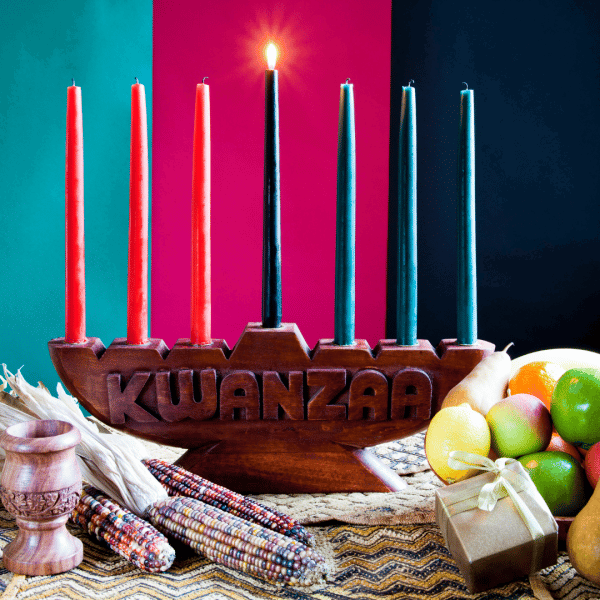
Lighting the Kinara
There are 3 red candles, 3 green candles, and 1 black candle. The colors represent the Pan-African flag. The candles are lit in alternating form, with the black candle being lit first then each candle from left to right being lit respectively. The black candle represents people-unity or Umoja. The first red candle that is lit represents the blood that was shed by the ancestors. The first green candle that is lit represents the abundant possibilities for the future. Each day you begin with lighting the black candle first, then the rest as follows. Most families select either the eldest or youngest member or a mix of generations to light the kinara.
If you have made it this far, then I’m sure you have noticed that every part of Kwanzaa is intentionally intricate. The ideal of Kwanzaa is to be reflective and accountable of our past, present, and future practices that affect our families and communities.
Kikombe Cha Umoja | Unity Cup
The Kikombe Cha Umoja symbolizes the unity of the family and/or community. Each night the cup is filled and passed among the family, beginning with the eldest family member taking a drink and then subsequently each family member.
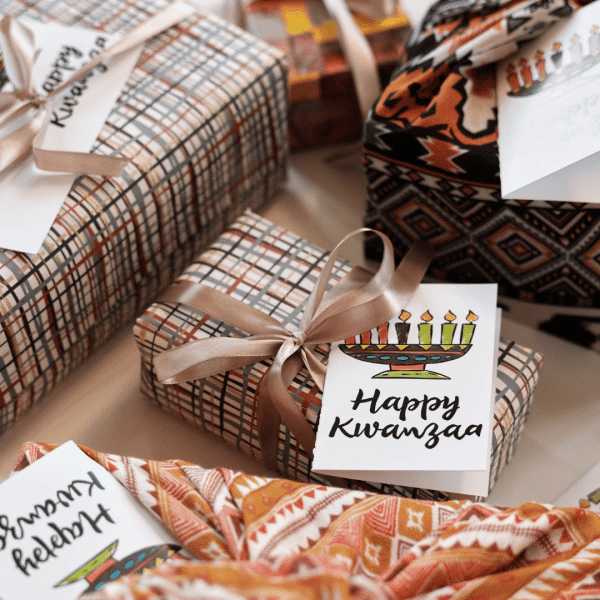
Zawadi | Gifts
Gifts are typically given to the children of the family. They are encouraged to be handmade and of sentimental and/or cultural value. If gifts are purchased, they are encouraged to be purchased from Black-owned businesses. Gifts are also to be reflective of the seven principles.
Karamu | The Feast
What is a celebration without the food? Karamu is held on the sixth day, December 31st (New Year’s Eve). There is no set menu for this feast but expect the cultural dishes that make-up the Black and African diasporas. Dishes such as collard greens, black-eyed peas, jollof rice, plantains, gumbo, curry chicken, sweet potatoes, mac-n-cheese, and so much more. Last year, I shared holiday recipes that remixed without the meat and dairy. The karamu represents the blessings of the harvest. My family loves watching holiday cooking shows and last year Food Network released a new show, The Kwanzaa Menu. It premiered Dec. 26th and featured recipes that compliment each of the principles.
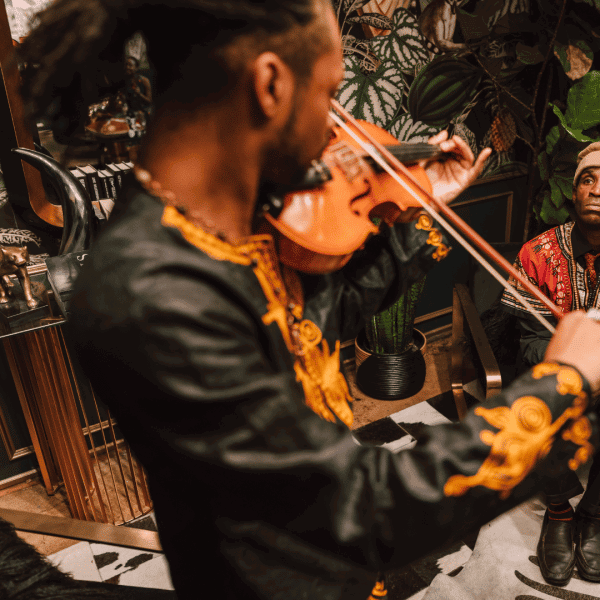
Celebrating Kwanzaa
All activities are reflective of the guiding principles of Kwanzaa. Activities that include storytelling, dancing, singing, education, and more. Children will love this week of nonstop crafts. During this time, support and encourage shopping at Black-owned businesses. The activities you choose for your family are left to your own interpretation as long as they coincide with the principles. Here’s how we celebrated a few principles last Kwanzaa:
- Day 1 – Umoja – A movie night filled with Black movies that upheld unity like Roll Bounce, Drumline, and You Got Served.
- Day 3 – Ujima – We cooked dinner as a family. Each member was responsible for their own dish.
- Day 4 Ujamaa – We supported only Black-owned businesses this day, including our dinner for the night.
- Day 6 Kuumba – We made drums and family bracelets to exchange with one another.
Typically on the last day (Imani), we are home reflecting of the past year and intention setting for the new calendar year. The day is grounded in gratitude, peace, joy, abundance, and love. No matter which day Imani falls on, it always feels like the perfect Sunday.
Since choosing to celebrate Kwanzaa, I have found that I’m more present and less stressed during the holiday season. I’m not frantically racing around town searching for gifts and entertainment for the family. Kwanzaa enters with a calming presence that will make you forget that you’re dead smack in the middle of holiday season. There is no rush. Again, Kwanzaa is nonreligious, so many celebrate Kwanzaa in addition with other holidays.
Kwanzaa serves as a reminder and encouragement to appreciate who we are, where we’ve been, and where we’re going.
